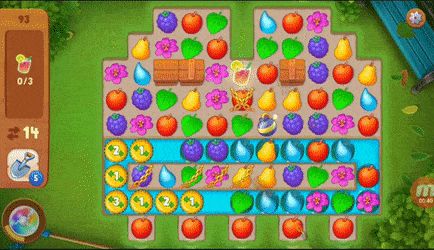About two weeks ago, my better half casually announced to me a jaw-dropping statement. You know, she mumbled while matching fruits at a dizzying pace on her (mine) iPad, I hadn’t touched the Zombie in 6 months or so.
The zombies – The game Plants Vs. Zombies by EA that was on heavy rotation since the day we’ve met five years ago. Apparently it is not spinning anymore and gave its place to Gardenscapes, a match 3 game by Playrix.
Overthrowing the zombies is not a matter to be taken lightly; therefore, a good excuse to check out Gardenscapes, the official Candy Crush successor, and see what has changed in the saccharine realms of match 3 games.
Match 3 – the perfect mechanic for mobile games.
After hundreds of hours of play I’m certain that this is the case, for three main reasons.
Pattern recognition
What do you see in this picture?

What do you see here?
The right answer is four lines. But you see a face. Our brain is constantly looking for patterns and rewards us for finding them. In this sense, a match 3 board is like a playing ground for the brain. The feedback loop it enhances is addicting. Search for a pattern, find one, match three of the same kind, get a reward. Rinse and repeat. Playing at a fast pace, the player transcends to a semi-meditative zone, going through this loop dozens of times in a level.
Infinite feedback loop
You cannot make a mistake in a match 3 game. When the player tries to match fruits that do not match they will snap back to their place automatically. There’s no punishment for wrong moves, turns are not spent, and the player stays in the zone as long as she has more turns to take.
When all turns are gone, the player is blocked immediately by a pop-up. In Gardenscapes’ case, this is starring Austin the game’s presenter and mansion’s butler, who stares at the player with a scowling expression and says, “Hey, wanna get back in the loop? Put in some money and jump right back to it!”

Austin’s never gonna give you up
Balance
Balance in match 3 games, in the right developer’s hands, can be truly adaptive to the player’s skill and even current mood. It’s almost a tailor-made game, something that is hard to accomplish in other genres.
This combo of the brain’s favorite sport, pattern recognition, the infinite feedback loop, and the tailor-made balance make match 3 games perfect for mobile experiences. Now let’s see what we can learn from Playrix, who truly mastered the art of the match 3 games.
Speaking of art…
Simple and effective art
Gardenscapes’ art is not exceptional. The fruits are simple and schematic, drawn in 2D. One might have expected from a company like Playrix to produce a higher quality art, especially when it comes to the fruits, which are the main game component.
Playrix avoided a beginner’s mistake and created the art to be effective at the cost of its beauty.
At the end of the day (literally speaking), the player is gazing at the match 3 board, filled with colorful fruits, searching for patterns. The more visually complicated the fruits are, the harder it is to find these patterns, and the barrier to entering “the zone” is higher.
I have numbers that support this theory.
A while ago I had a chance to work a little bit on Epic Dinner Spinner, Nitako’s wonderful match 3 game. At the time of the game’s launch, their game pieces (cute little vegetables), were designed in great detail. They all had eyes, facial expressions, and cute little animations.
In one of the endless A/B testing situations that Nitako were committing, they decided to simplify the art and remove some of the details. The result that came in was staggering: Over 5% increase in first day retention.
Lesson learned. In a match 3 game, keep the art simple!

Nitako’s game before the change
Animation from outer space
Whatever Gardenscapes lacks in art it makes up for in animations.
Watching the game board when a seasoned player is playing is mesmerizing. The player doesn’t stop for a second to think, plays in 50 MPM (match per minute), and the board responds to the player’s actions accordingly, resembling a lightning storm watched from space.
Fruit chains collapse into themselves, flowers fly into the progress bar on the right, the powerup meter fills up and flies into the board, garden gnomes fly out of the board, and so on and so forth.
The animations never occur in parallel, but one after the other in 0.1-second intervals.
The dazzling result is the true reward for the pattern-seeking brain.
As you know, variable rewards (sometimes a small prize, sometimes big, sometimes none) is a recipe for addiction in games, and not only in games. As I was taught by Dr. Lavie, my psychology teacher, if you want to make someone fall in love with you, treat her sometimes nicely, sometimes nasty, and sometimes ignore her completely. She will fall in love. Guaranteed!
I never tried, but it does work very well for Gardenscapes. The geniuses at Playrix understood that the real reward for their players is not a score, or a star, but the animations, the chain reaction of lights and sounds that goes through whenever the player cascades a match.
This is a variable reward, as it ever changes. Short reactions, long reactions. Every now and then, huge reactions that clear the whole board. Like a seasoned Shiatsu therapist with a golden touch, these animations massage the player’s weary brain and put it in a warm and cozy zone.

Extra rewarding animations
Maps – out! Mansions – in!
Let’s talk metagame. Metagame is the game that wraps around the main game, whatever happens in between levels. In the Candy Crush regime, the map was the king. A social map where players could track their friends’ progress and compete with them on high scores.
This is no longer cool. Playrix understood that their players have no interest in competing against their friends or even to go back to previous levels. Furthermore, some players may find it embarrassing to show the world their current level in the game, thus insinuating the amount of hours they put into it.
So the map is officially out. There are two other metagame components instead of it: customization and a story.
The story
Gardenscapes is story heavy. Full of dialogue, an array of characters, and, of course, Austin, the eternal butler, never really shuts up. I found the story utterly boring, but obviously some people are very interested in it.
Looking up the game on YouTube, I’ve stumbled upon more than a few full-length videos featuring only the story, and not even a single match 3 board is mentioned.
I asked my spouse if she feels that she has a deep relationship with Austin the butler. She declined, but told me that she does have a very meaningful relationship with her mansion. By the amount of hours she put into renovating the place, it’s understandable.
Customization
As the player advances in the game she unlocks different territories in the mansion. Every new territory can be renovated and customized to the player’s taste.
These “customization breaks” between the hectic match 3 levels add a different, relaxing pace to the game. Not only that, but the idea of putting a messy place in order is the same principle behind the core match 3 premise.
However, while the match 3 boards will never be in order, there’s a comfort in permanently fixing up the mansion, making it more beautiful as the game develops.

My digital gateaway
The Handmaid’s Tale
Gardenscapes is the new match 3 king, by a company that obviously knows their audience very well.
I find it funny that when games started to break out commercially, 47 years ago, saving the galaxy was a very common theme. Nowadays, casual games put their players to work in the garden.
Who would have thought this kind of work could prove so addicting?

Awesome article! We’ve seen loads of deconstructions glorifying metagame innovations which supposedly set Gardenscapes apart from the competition. I agree to some extend, but what set it apart and made it’s success is Match 3 really. I think you forgot to mention unique special element mechanic and stellar level design built around it. To my mind, that’s most important thing that sets it apart form all other match 3 games.
I totally agree that everything is built on the very balanced level design. I took it for granted that for a game of this caliber this has to be the case and tried to shed light on different aspects of the game.